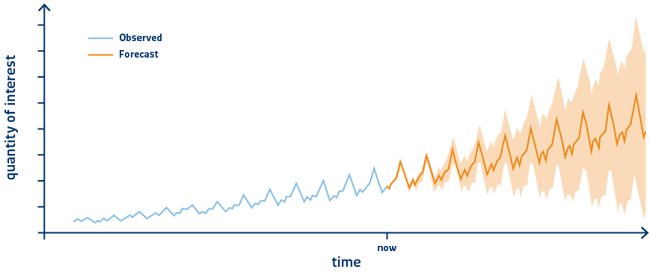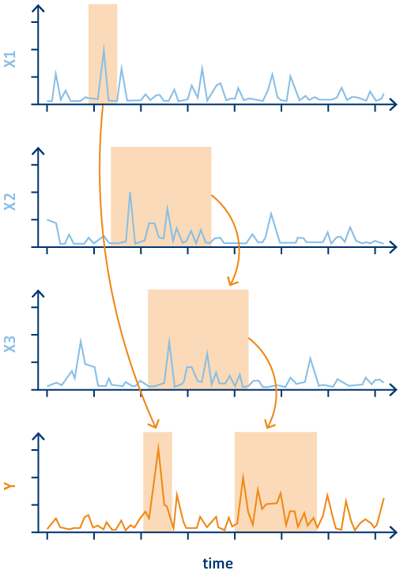Dr. Holger Brandl, on January 12, 2021, 09:42 AM
Predictive Analytics: Enabling robust planning & factory optimization
Research and support for this article was provided by Dr. Lutz Muche.
Factory control is all about anticipating the future state of a manufacturing site. To ensure that due dates are met, materials accumulation is avoided, and standby times of expensive tools are minimized, factory control engineers need to establish an execution scheme that details out the complex spatio-temporal interplay of human, machine, method and material (4M). A lack of such planning would result in missed due dates, idle equipment, or mountains of unfinished material. In contrast, properly executed factory control enables well-balanced lines and happy customers.
Planning engineers are sometimes thought to have developed a seemingly magical 6th sense for proper line balancing. However, in fact their real power comes from their ability to disentangle the complex dependencies between the 4M. Empowered with this mental model and supported by computational tools to anticipate factory dynamics, control engineers provide planning and execution support to run production at scale.
The holy grail of factory control and planning is a system that allows predicting a future state of a factory given its current state regarding the 4M. With such a system, planning could be adjusted to find the most effective execution plan for any given business objective. However, such a production planning system would require that all events are determined completely by previously existing causes. This concept known as determinism intrigued some of humankind’s greatest philosophers since millennia: In 1814 Pierre-Simon Laplace considered a demon knowing the precise location and momentum of every atom in the universe. With laws of classical mechanics, their past and future values for any given time would be entailed. Laplace’s daemon has long-since been disputed and was formally disproved just a few years ago. The bottom line: the future is non-deterministic.
Consequently, there can not be a perfect production planning system. The good news is that approximations built with math, models and machine learning still allow anticipating the impact of planning decisions with some uncertainty. The underlying factory mechanics need to be unravelled as much as possible to achieve this goal. Our intent is to shed some light on how machine learning and statistics provide the means to forecast factory state by accounting for the complex interplay of human, machine, methods and material.
What is Forecasting?
Forecasting is the process of making predictions of the future based on past observations. It is a predictive method that relies on correlation patterns between a business variable of interest and one or more predictor variables. A popular example is the temperature forecast in the daily news. It is computed with data from wind-sensors, thermometers, satellite imagery and a huge body of historical evidence.

Typically forecasting is treated as a subclass of regression, i.e. it allows to estimate a numerical variable of interest at some specified future date. However, also categorical predictions (e.g. will it rain tomorrow?) can be considered as a forecast.
As discussed in the introduction, philosophers have disproved the possibility of a perfect forecasting solution. Thus, any forecast becomes blurrier the further we try peeking into the future. In more technical terms, the uncertainty about the forecasted value increases for more distant predictions. This is often illustrated as confidence band around the predicted value.
Why do classical statistics fail for predictions in manufacturing?
Classical approaches to time series analysis can often only insufficiently address the complex spatio-temporal interplay of human, machines, methods and material. Interrelationships in factory control are very complex, and transitions between states are discrete in time, which is often not compatible with the expected data shape used in statistical tools. Thus forecast quality obtained by applying classical statistics is often not good enough to enable planning and optimization in manufacturing.

Figure 1: Interplay of processes in manufacturing. A sequence of processes (e.g. WIP on operations or equipment), which drive material towards each other. Predictions of individual curves into the future are not very meaningful. Instead, it is essential to model spatio-temporal dependencies between processes.
With recent advances in machine learning and AI, a new powerful methodology has emerged that supports the complex shape of 4M data. In contrast to statistics, these new tools can learn to disentangle dependencies between human, machine, method and material. By building a representation of the inherent factory mechanics, they allow to predict and forecast factory state with yet unseen precision.
Example Applications in Manufacturing
There is not yet a single holistic approach to factory forecasting. To enable planning, factory control engineers rely on different forecasts for different metrics and KPIs. For instance, in semiconductor manufacturing, the diversity and variability within production processes make forecasting indispensable for planning, optimization and decision-making. Specific applications range from the planning of future maintenance to the prediction of logistical key indicators. For example, forecasting helps to
- Avoid or minimize idle times by ensuring a continuous material flux
- Predict capacity bottlenecks and material accumulations
- Predict due dates to enable prioritization
- Predict trends in product properties to pre-anticipate and avoid quality issues
- Forecast critical tool states to enable predictive maintenance
As diverse as these examples may look at first glance, they all rely on an integrated, enriched data context. These data need to be collected, integrated, and operationalized to enable AI-driven forecasting.
Manufacturing Data Provisioning
Manufacturing data ships in many different shapes and flavors which need to be condensed into formats suitable for predictive analytics. Data is typically enriched across multiple data sources. For example, very often, machine interfaces provide start and stop events indicating productive cycles (machine). Shift-plans detail out operators and their capabilities (human). Material tracking provides insights into where accumulations occur and routing may lack efficiency (material). IIoT can enrich data and provide more information about processes. More specifically, IIoT could provide temperature or vibration curves while a tool is in production (method).
Although data tooling has matured considerably over the last years, it remains a challenging task to implement such solutions. In particular, the velocity, the volume, and variety of these data require a scalable infrastructure and a cutting-edge computing paradigm. Key to success is an efficient model approach and the integratration of event streams to ensure fault-tolerant, exactly-once semantics at millisecond precision in real-time.
SYSTEMA provides support to integrate 4M data across a wide variety of such systems including MES, FDC, SPC or EI. From our daily work and years of project experience, we know: every data source is a unicorn in manufacturing, that requires special care and handling to provide insights. With solutions, such as our Equipment Integration Suite, we can help to establish a normalization layer that enables factory-wide analytics and forecasting.
Summary
Production planning relies on the ability to anticipate the future factory state. With increasing complexity in manufacturing, even the brightest minds in operations rely more and more on computational tools centering around predictive methods, such as forecasting, to support analysis and production planning. Data integration is key to enable predictive methods in manufacturing. Just by building a rich picture of what's happening on the shop floor, we can capture the complex 4M interplay of human, machine, material and methods. Once data integration is established and operationalized, predictive methods such as forecasting can lift key metrics such as efficiency or due date adherence to a new level.
We would like to thank the European Regional Development Fund (ERDF) under co-financing by the Free State of Saxony for supporting our research (funding code 100320128). Together with the Technical University of Dresden, we teamed from 2017 through fall 2020 to develop a real-time capable forecasting concept for optimizing production planning in modern semiconductor manufacturing. In this project, we successfully devised, implemented and operationalized real-time forecasting for key performance indicators such as WIP or OEE.
By combining our extensive experience in modelling and automating factory control processes at SYSTEMA with latest advancements in AI, we kickstart and support initiatives that enable data-driven decision making and high-automation. It is certainly not an easy path from scattered data pieces to holistic AI-driven planning. However, in an automation-oriented economy, sound planning is an essential cornerstone for sustainable success across many industries. Feel welcome to get in touch with us, to explore if and how we could support your exciting journey towards Factory4.0.
Be the first to comment.